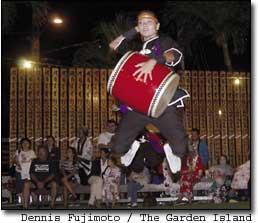KAPA’A — The sounds, sights, and smells of the bon dance returned to Kaua’i Friday and Saturday nights, when leaders of the Kapaa Jodo Mission hosted the first of the weekly bon dances at their temple grounds. For local residents,
KAPA’A — The sounds, sights, and smells of the bon dance returned to Kaua’i Friday and Saturday nights, when leaders of the Kapaa Jodo Mission hosted the first of the weekly bon dances at their temple grounds.
For local residents, it was a time to gather and catch up on the latest community events, while visitors were treated to a sensory treat, with the string of overhead lights creating an ambiance punctuated with the brilliantly-colored kimono and happi coats.
For others, like the Japanese exchange students from Kapa’a, it was one of the final tastes of the island before they head back to Japan, and even Russia.
Contained within a roped-off circle, a central yagura houses a taiko that is played to accompany the recorded music that blares from loudspeakers. That segment is followed by the iwakuni, where a live singer and the taiko drummer make the only sounds to guide the dancers.
Bon celebrations originated from the Buddhist religion over 500 years ago, when it is believed that the souls of ancestors who passed on returned to visit this world during the bon season, which usually is celebrated between July 13 and July 15 in Japan.
The strings of overhead lights that are punctuated with paper lanterns serve to guide the souls to the bon dance, where they can enjoy the dancing by their relatives.
On the mauka boundary, a row of planks inscribed with Japanese calligraphy indicates the names of late ancestors, and families of those celebrating the return of their ancestors.
Inside the temple, special decorations including an abundance of paper lanterns are set up for the celebration, and in one section of the church, a collection of foodstuff represents contributions from members and supporters. Some of these foods will be placed in the lead boat that pulls a flotilla of paper lanterns during the toro nagashi, or the ceremony that marks the return of the souls to their spirit world.
In Hawai’i, bon celebrations have become social gatherings and major fund-raisers for temple leaders and volunteers, with neighbors coming together at the hosting church’s temple grounds to indulge in fellowship, conversation, and good food, some of which may only be found at the bon-dance celebrations.
Gary Furugen, who was manning the shave-ice machine, said that, this year, there was some concern about the parking for the bon dance, but at the last minute, they got some cooperation from the Jasper family, whose leaders allowed church officials to utilize an empty lot next to —Otsuka’s Furniture & Appliances. In addition to the shave ice, there are the pronto pups, the teriyaki sticks, andagi (Okinawan doughnuts), saimin, and other delicacies, including sushi, which can be found in the country store along with a variety of fresh produce and assorted rummage items. During the intermission, guests were treated to a performance by the Ryukyukoku Matsuri Daiko, a dynamic Okinawan taiko form that was introduced to Kaua’i several years ago by sensei Akemi Martin. Leaders at nearly every Buddhist temple host dances.
- Dennis Fujimoto, staff writer and photographer, may be reached at 245-3681 (ext. 253) or dfujimoto@pulitzer.net



